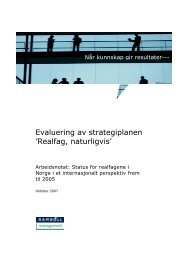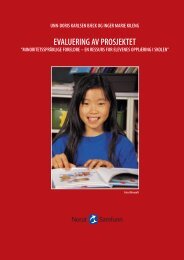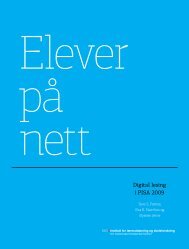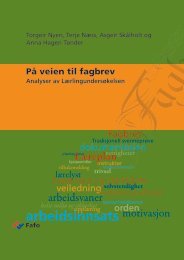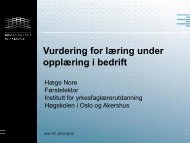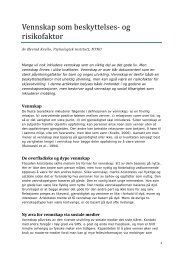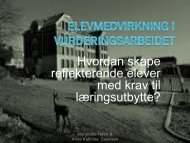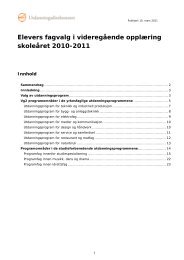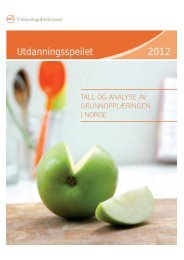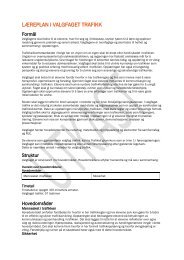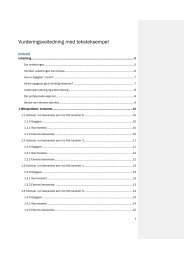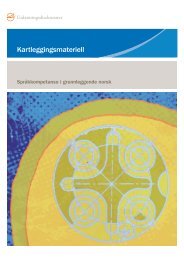Vedlegg 5: Bakgrunnsdokument om vurdering for læring - Udir.no
Vedlegg 5: Bakgrunnsdokument om vurdering for læring - Udir.no
Vedlegg 5: Bakgrunnsdokument om vurdering for læring - Udir.no
You also want an ePaper? Increase the reach of your titles
YUMPU automatically turns print PDFs into web optimized ePapers that Google loves.
Teoretisk bakgrunnsdokument <strong>for</strong> arbeid med <strong>vurdering</strong> <strong>for</strong> læring<br />
Nasjonalt k<strong>om</strong>petansemiljø i <strong>vurdering</strong> 2012<br />
11 Litteratur<br />
Andrade, H.(2010). Students as the definitive source of <strong>for</strong>mative assessment. I. H.<br />
Andrade and G. Cizek (Red). Handbook of <strong>for</strong>mative assessment. New York,<br />
Routledge. s.90-105.<br />
Andrade, H. and Cizek, G. (red). Handbook of <strong>for</strong>mative assessment. New York,<br />
Routledge. s.90-105.<br />
Arter, J. og McTighe, J. (2001). Scoring Rubrics in the Classro<strong>om</strong>. Using Per<strong>for</strong>mance<br />
Criteria <strong>for</strong> Assessing and Improving Student Per<strong>for</strong>mance, Thousand Oaks,<br />
Cali<strong>for</strong>nia. Corwin Press.<br />
Baird, J. (2011); Does the learning happen inside the black box? I, Assessment in<br />
Education. Principles, policy and Practice. Bind 18, nr. 4, s343-346.Bennett, R.<br />
(2011). Formative Assessment. A Critical review. I, Assessment in Education,<br />
bind. 18, s5-25<br />
Ball, D. L., Hill, H. og Bass, H. (2005). K<strong>no</strong>wing mathematics <strong>for</strong> teaching; Who k<strong>no</strong>ws<br />
mathematics well e<strong>no</strong>ugh to teach third grade, and how can we decide? American<br />
Educator, Fall (s14-22 og 43-36).<br />
Ball, D. L., Thames, M. H., og Phelps, G. (2008). Content k<strong>no</strong>wledge <strong>for</strong> teaching. What<br />
makes it special? Journal of Teacher Education 59, (5), 389–407.<br />
Bennett, R. (2011). Formative Assessment. A Critical review. In, Assessment in<br />
Education, Bind 18 nr. 1, s5-25<br />
Bernstein, B. (2001). Pedagogy, symbolic control and identity (London, Taylor og<br />
Francis).<br />
Berge, K.L. (2005). Skriving s<strong>om</strong> grunnleggende ferdighet og s<strong>om</strong> nasjonal prøve -<br />
ideologi og strategier. I A. J. Aasen og S. N<strong>om</strong>e (Red.), Det nye <strong>no</strong>rskfaget (s.<br />
161–188). Bergen. Fagbok<strong>for</strong>laget<br />
Birenbaum, M. (1996). Assessment 2000. Towards a pluralistic approach to assessment.<br />
I M. Birenbaum og F.J.R.C. Dochy (Red.), Alternatives in assessment <strong>for</strong><br />
achievement, learning processes and prior k<strong>no</strong>wledge (s. 3–29). Boston, MA.<br />
Kluwer.<br />
Birenbaum, M. (2003). New Insights Into Learning and Teaching and Their Implications<br />
<strong>for</strong> Assessment. I M. Segers, F. Dochy og E. Cascallar (Red.), Optimising New<br />
Modes of Assessment. In Search of Qualities and Standards (Vol. 1, s. 13–36).<br />
Springer Netherlands.<br />
Black, P. og Wiliam, D. (1998). Inside the black box. Raising standards through<br />
classro<strong>om</strong> assessment. London. King’s College London.<br />
Black, P., Harrison, C., Lee, C., Marshall,B, William, D (2002). 'Working inside the Black<br />
Box - Assessment <strong>for</strong> Learning in the Classro<strong>om</strong>'. Phi Delta Kappan Volume 86,<br />
Issue: 1: 9-21<br />
Black, P. og Wiliam, D. (2005). Changing teaching through <strong>for</strong>mative assessment.<br />
Research and practice. I CERI (Red.), Formative assessment. Improving learning<br />
in secondary classro<strong>om</strong>s. Paris. OECD.<br />
Black, P. og Wiliam, D. (2006). Assessment <strong>for</strong> learning in the classro<strong>om</strong>. I J. Gardner<br />
(Red.), Assessment and learning. Theory, practice and policy (s. 9–25). London.<br />
Sage Publications.<br />
Black, P. og Wiliam, D. (2009). Developing the theory of <strong>for</strong>mative assessment.<br />
Educational Assessment, Evaluation and Acountability, 21 (1), s.5-31.<br />
Blo<strong>om</strong>, S (2006). Foreword. I, Benjamin S. Blo<strong>om</strong> . portraits of an educator. Red.<br />
Guskey, T. Lanham. Rowman og Littlefield Education<br />
Boston, Carol (2002). The concept of <strong>for</strong>mative assessment. Practical Assessment,<br />
Research og Evaluation, 8(9). Lest 5. januar 2012 fra<br />
http.//PAREonline.net/getvn.asp?v=8&n=9<br />
Broadfoot, P.M. (1996). Assessment and learning. Power or partnership? I H. Goldstein<br />
and T. Lewis (red), Assessment. Problems, developments and statistical issues.<br />
Chichester. John Wiley og Sons Ltd.<br />
31



